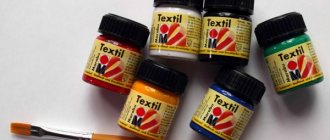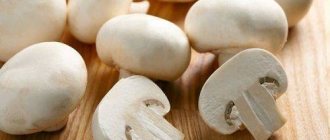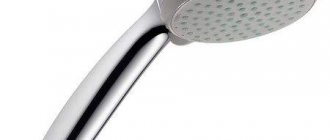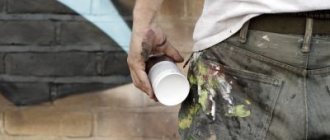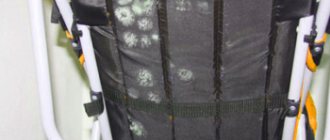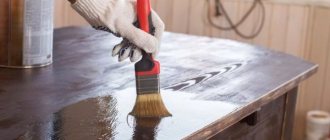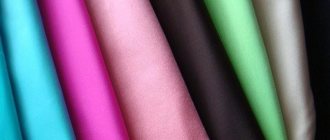Do you want to diversify your wardrobe, experiment with faded T-shirts, or restore favorite items that have lost their former appeal? Special fabric paints will help solve these problems. They allow you to show your imagination, create a unique image and your own style. These paints are easy to use at home, you just need to know the basic rules and nuances.
What types of fabrics can be dyed
The most flexible materials in this regard are those made from natural fibers: silk, linen, cotton and wool. Fabrics made from mixed fibers are less susceptible to dyeing. Polyester is the worst dyed material, since its fibers almost do not absorb pigment. As a result, the color of the fabric will turn out to be pale and will fade when washed.
Advice! If a jacket made of synthetic material has lost its appearance, it is better to take it to the dry cleaner for painting. Specialists use professional coloring agents, which have an effect only under strict adherence to temperature conditions and special conditions.
At home, you can change the color and shade of dresses, T-shirts, shirts, skirts and towels without much effort. Painted denim products are very popular.
All dyes are divided into the following types:
- aniline;
- acrylic;
- natural;
- plastisol;
- stamped.
The paint must be selected based on the expected result and the composition of the fabric fibers. Aniline and natural dyes are processed to obtain a uniform color. Acrylic or luminous paints are perfect for painting on fabric.
How to prepare an item for painting
Before proceeding directly to the process, you need to carefully familiarize yourself with all the nuances of this process:
- things that have light shades can be painted in any tone;
- For clothes with bright colors, only dark colors can be used. It’s nice to bleach it first;
- You need to carefully read the composition of the fabric. Since the final result will depend on this. For example, natural materials can be dyed quite easily, while artificial ones may not change their original tone at all;
- the process of dyeing matter is performed exclusively on clean things. Therefore, before the process it must be washed;
- The item of clothing that will be dyed must be weighed. This is necessary in order to find out how much pigment is needed;
- The coloring process must be performed in distilled water. When using tap water, it is necessary to soften it with soda. Proportions – 1 tsp. soda for 10 l. water;
- After the painted clothing has dried, it is covered with another layer of dye, using it to draw all the small details. Coloring clothes in several layers will give things unusual shades.
Aniline dyes
This type of permanent paint comes in liquid or powder form. Used for uniform dyeing of fabrics made from natural fibers.
Synthetics usually change color poorly, as well as mixed materials containing more than 60 percent artificial fibers.
The procedure for working with aniline dyes is as follows:
- The color is diluted with a large volume of water in a ratio of 1/30 or 1/40 to the weight of the material. For example, for a towel weighing 100 grams, you can use 3 or 4 liters of dye solution.
- The fabric is completely immersed in liquid and boiled at 95 degrees. If you boil longer, the color will become brighter.
- To fix the color at the last moment, add 2-5 tablespoons of table salt.
- When dyeing a wool product, you must additionally add two tablespoons of vinegar to the water. For cotton - baking soda.
- After finishing the painting process, the product should be rinsed in cool water. During the first three washes, the item will most likely fade, so it is better to wash it separately.
The method described is batik dyeing. You can achieve a different result by working with aniline dyes:
- Gradient . The material is gradually lowered into a container with a dye at regular intervals. Then the part of the fabric immersed in paint for a longer time will be a couple of tones darker than the part that was immersed much later.
- Divorces . The material is twisted by hand, as if squeezing, and tied tightly with a cord. In this form, the fabric is boiled in a dye solution.
- Knot pattern . Coins or buttons are wrapped in cloth, threaded, and the material is boiled in dye. The result is a characteristic ray-shaped pattern.
How to use a washing machine for painting
Things in the car can be painted in half an hour. To do this, you will need to dilute the pigment as indicated in the instructions. Place the solution in the powder compartment. Place the item to be dyed into the drum. First you need to moisten it with water and set a program that uses hot water - up to 95 degrees.
The process should last at least 30 minutes. When finished, rinse the clothes thoroughly in cold water. After dyeing in the machine, parts of the dye may remain on the drum. They need to be removed. This can be done by dry washing with hot water and adding a little bleach.
Acrylic dyes
They are better suited than others for painting cotton, wool and silk fabrics. They are convenient for creating both bitmaps and real masterpieces. Original colorful clothes will highlight your individuality.
The technique of painting with indelible acrylic paint is similar to working with gouache or watercolor. First you need to apply contours to the material with a pencil or a specially designed marker, then use a natural brush.
Acrylic dyes that have a water-dispersion base are used for painting fabrics. They lend themselves well to dilution with water, have no odor, and when completely dry, they become indelible. However, in order to avoid stains, such clothes should be gently washed by hand with water heated to no more than 40 degrees.
Acrylic paints are available for sale in cans, tubes and spray form.
The highest quality acrylic dyes are produced by manufacturers:
- Decola;
- Dylon;
- Simplicol;
- Marabu.
TOP 10 tips for dyeing clothes yourself
After dyeing, wash the item 4-5 times separately from other items, as some of the dye will still wash off and may stain your other clothes.
Wash the item before you dye it.
Always use gloves and old clothing.
Seal all metal parts tightly with tape in advance.
Do not attempt to dye synthetic clothing yourself. If the synthetic content is more than 50%, the paint will not adhere correctly and the result will not stick.
Do not try to dye dry fabric, it should be 30% wet after washing.
Natural dyes
There are many plants in nature that can give fabric fibers a bright shade:
- vegetable juices;
- fruits and berries;
- onion peel;
- turmeric;
- Oak bark;
- tea;
- coffee;
- lemon and orange zest;
- nettle leaf;
- and many others.
Their main advantage is environmental safety. If you are susceptible to allergic reactions, then you should not use synthetic dyes. There are so many natural pigments around that can transform your items!
The dyeing technique is similar to working with aniline dyes for fabric, the difference is that the aqueous solution is not brought to a boil. It is enough to heat it to 60 degrees and hold the item in it.
The color fixing process is carried out using a 1% aqueous solution of the following substances:
- copper sulfate;
- ferroammonium or potassium alum;
- potassium bichromate;
- tin chloride.
It is necessary to soak the fabric in the prepared solution for about 25 minutes, then rinse it in a weak vinegar solution. In clubs you can often meet people with luminous patterns on their sneakers and suits. Extraordinary images are created with special fluorescent paints based on plastisol.
The following varieties are available for sale:
- glow in the dark and also when exposed to ultraviolet radiation;
- glow only in ultraviolet light.
There are also invisible and visible paints. The former look white in daylight, but in the dark they begin to emit yellow, blue, green and other colors.
Dyes for materials
The most popular fabric paints are acrylic and natural. They are the most affordable, and the results almost always last up to 20 washes. Such substances do not affect the human body because they do not contain ammonia or other toxins. For needlewomen, it is recommended to use powder dye. It is convenient to stir it and control the exact amount needed for the product.
Acrylic paints
These dyes are good because they require minimal preliminary preparation. Drawing on fabric is as easy as drawing on paper. But, it is advisable to understand that to apply a pattern to a thing you need to use a stencil.
Textile dye
This way the drawing will turn out clear and without blurring along the contour.
Important! Paints can be diluted with water, but not too much, otherwise all their properties will deteriorate.
Since acrylic paints dry quickly, the jar should not be left open for more than an hour. Otherwise, all its properties will be lost. If you need to trace the lines of the drawing carefully, it is recommended to buy a special outline for clothing.
Turmeric for yellow color
Aniline dyes
These are organic substances that are formed as a result of the oxidation of aniline. The main component, aniline, was derived from natural indigo. Scientists have been able to prove that bright colors can be made using it. Aniline dyes are partly used in production for dyeing things. At home, fabric dyeing with such paints is not done.
Natural dyes for fabrics
Natural dyes are taken from food, seasonings and other things. The most popular are turmeric (for the yellow color), barberry, buckwheat, blackberry, blueberry, etc.
Traditional methods
Many people use such paints because they are safe and do not cost too much. But painting with such means is a rather labor-intensive process. For green color, medicines such as brilliant green and potassium permanganate are used. Brown and dark colors could be obtained by mixing black coffee, onion skins and tea. For blue and gray colors, currants are usually used. The entire process of cooking the fabric will take about three hours. But the color will last longer than with any store-bought paint.
Stamp type inks
Used in laundries and hotels to place markers on bed linen, towels and other fabric supplies. They are diverse in chemical composition:
- alcohol-based - characterized by rapid drying and resistance to boiling and even bleaching;
- oil-based - quite durable, but the drying process is slow;
- water-glycerin - absorbed instantly, do not smear, can withstand heating up to 70 degrees, often black;
- colorless - invisible under normal lighting, visible under UV radiation, used for hidden marking.
The process of dyeing fabrics is very exciting and will give your favorite items a unique look.
Natural dyes for fabric are one of the components of health and purity of life
05.08.2019
We are accustomed to an abundance of fabrics of various colors and shades and often do not even think about how one or another was obtained - we simply choose the one we like. More recently, our ancestors used plants as dyes, those that grew within reach. It is both environmentally friendly and filled with living energy. And this work was painstaking, manual. And now fabrics are dyed with chemical dyes in large factories by machine. Then microscopic chemical components, through the clothes we wear, through the linen we sleep on, enter our body, first on its surface, and then inside... Imperceptibly depriving us of health and strength.
Now that sanity takes precedence over the thirst for cheapness, variety and having as many things as possible, we are increasingly inclined to use only natural substances for all household purposes. And herbal dyes are great helpers for us in this.
The ancient art of dyeing fabrics using natural methods is being revived these days. And if at the same time we use herbs grown with a caring hand in our own garden, then the clothes we wear are filled with greater meaning and protective power.
Richness of natural dyes
The possibilities of the plant kingdom are great. What exactly did the Russians use for dyeing? How did you paint it and what colors did you get?
Plants that accumulate dyes – pigments – in various organs (roots, stems, leaves, flowers, wood, bark) and tissues are considered to be dyeable. Some crops were previously used on an industrial scale, specially grown for this purpose.
In modern conditions, for the needs of one family, only 3-10 plants are enough, which can be successfully integrated into a country flower garden or created from them as a hedge.
Yellow and brown
Having decided to get solar coloring, our ancestors could use more than two dozen plants. Some of them were used entirely: immortelle, heather, cuff, navel, string. And in the genus of gorse, shrubs and subshrubs of the legume family, there is even a species that is called just that - dyeing. For the same purpose, flowers and leaves of goldenrod (also called golden rod), jumper (also having a second name - impatience), and sickle grass were used. Only flowers were taken if it was about the umbrella hawkweed and, oddly enough, the meadow cornflower, and also the horned frog. By the way, the leaves of birch and black grass (or verbolosis) were used.
The zealous owners also did not forget about the root system of plants: sorrel and iris turned out to be useful here (it received a very affectionate nickname - iris). And the bark was taken from hazel and wild apple trees for dyeing purposes.
Sometimes certain plant parts were chosen based on the material to be dyed. Thus, the leaves and stems of the moss moss (aka the ram), as well as the flowers of the rapeseed, were taken into account when working with wool, and the swimsuit was used only for canvas.
Yellow dyes
Voskovnik
, a low shrub with large leaves, common in the north of Russia, has several varieties known as wax berry, wax heather, etc.; the fruits have a waxy layer. Waxberry has a lot of coloring matter, giving it a bright yellow color. As experts note, the dye from this plant is very resistant to fading.
Bearberry
- bear grapes, similar in appearance to lingonberries, the berries are mealy, grows in sandy areas and in pine forests, must be collected after the berries appear. Gives a yellow color.
Buckthorn
— wolf berries, the coloring matter is in the bark. It grows throughout Russia and has many local names: buckthorn, medzhina, prickly buckthorn, laxative, okoster, proskurina, etc. The bark of some types of buckthorn gives a yellow color when fresh, and brown when dry.
Angular cornflower
- leaves dye silk and wool.
Basilisk
- Leaves dye wool.
centaury
- grass dyes wool.
Monoberry
- paints the canvas.
Sagebrush
- the grass colors straw and fawn, with alum - lemon color.
Bedstraw
- flowers with the addition of alum are painted dark yellow.
Barberry
- bush. The dye is obtained from bark, roots and wood.
Zheltinnik
- in Ukraine called skompia, the coloring substance in the leaves and young branches, collected in August, dried, crushed and ground.
Brown dyes
Lichens, torchovka, oak foot
- grow almost everywhere, on the ground and stones. Lichen growing on stones produces a particularly durable brown color.
Black alder
- common in temperate Russia, coloring matter in leaves, young branches and bark.
Dry buckthorn bark
- gives a brown color.
Plum tree bark
- gives a brown color.
Serpukha grass
— dyes linen and silk fabrics.
Horse sorrel
- its root, dug up in the fall, gives a brown color.
Orange and red
To make the canvas “red,” there were significantly fewer folk methods. This could be provided by black alder bark. And in order to achieve the desired result with the help of celandine, alum was added to it.
In the red range there were more possibilities and, mainly, the roots of plants were used as dyes, in particular, cinquefoil (also called cinquefoil and silver), buckwheat (i.e. crayfish necks), soft bedstraw (this is a cosmos grass) true bedstraw (we are talking about rennet - yellow porridge). If the material was wool, then they used the roots of St. John's wort. But there was also a ground part of the grass, thanks to which the tissues “turned red”: this is white pigweed, or, more simply, quinoa.
Blue, blue and green
The blueness of the canvas was given with the help of ash bark, and if it was necessary to dye wool, cornflower or buckwheat flowers. Bird buckwheat (popularly called ant grass) is capable of turning the material blue, and the whole plant is used, like woad. This same woad was used as a dye for woolen materials and was highly valued in the handicraft carpet production.
Blueberries were used to dye flax blue and wool blue.
By the way, the just mentioned woad-krutik was also used to obtain green color. However, along with other plants.
Blue dyes
Moss lycopodium
- herbaceous plant; coloring matter in the stem of a plant.
Vaida
(sinilo, chenille, farbovnik) - grows in temperate Russia, the coloring matter is contained in the leaves.
Buckwheat
- growing wild on the shores of the Caspian Sea. The coloring matter in the leaves is deep blue (indigo).
Forest geranium
- coloring matter in flowers.
Blackberry
- the berries are painted dark blue.
Blueberry
- the berries dye wool soaked in alum (1:10) purple.
Litmus test
— grows in Crimea. The grass dyes the wool purple, known by the French as Tournesol.
Meadow sage
- The grass turns dark blue.
Green dyes
Elder
- they do not use ripe berries, as for red paint, but elderberry leaves, which give a good green color.
Swamp horsetail, ironweed, squirrel tail
- grows everywhere; The coloring matter in the stem gives the green color.
Sorrel
- grows almost everywhere; coloring matter in leaves.
Juniper
- grows almost everywhere; coloring matter in berries.
Rue and blue iris flower
- the juice from them, mixed together, gives a strong green color.
Privet
- The berries color the fur dark green.
Bird cherry
- The inner bark turns green.
Poplar
- the inner bark dyes the yarn green, the yarn must be pre-moistened with iron sulfate (1:10).
Black
In order to achieve the black tone of the material, several plants were used. These include berries and roots of voronets (funnel), meadowsweet bark, leaves and stems of podbel, bearberry leaves (in other words, bear's ears) and the juice of a herb with the amusing name of brilliant zyuzik. It has a number of popular names: water horehound, wolf's foot (or paw), wild queen plant, forest hemp, marsh nettle, speckled grass, heart grass, chistets).
A decoction of onion peels, juices of beets, carrots, and green crops (parsley, dill) are used as food colorings; juice of chokeberries, blueberries. It is interesting that not only higher plants, but also mushrooms are used as dyes.
In your herb garden, you can create a herb-dye corner. They can be grown among other crops or placed separately.
General rules for collecting and preparing dye plants
- for harvesting flowers and inflorescences - during the period from budding to the end of flowering;
- for harvesting roots and rhizomes - dig up late autumn or early spring;
- to harvest grass or above-ground parts, the plants are cut with a sector (or a small sickle) fresh, not withered: in the evening - before the dew appears, in the morning - after it disappears;
- harvest only in dry weather or after the plants have dried from the rain;
- The collection of raw materials is carried out (according to the part of the plant to be harvested): flowers - almost blossomed, but not wilted; leaves and stems - mainly before flowers bloom; fruits - at the moment of maturity; roots - in spring or autumn;
- the collected plants are laid as loosely as possible or hung;
- When using freshly squeezed juice, it is made immediately after harvesting the raw materials.
Stages of vegetable dyeing of fabric
The collected plants must be chopped, filled with water and boiled.
After boiling the solution, it is best to leave it to cool overnight along with the plants, so they will infuse and give up all their coloring matter. The next day, you need to remove all parts of the plants from the water. Now the aqueous solution of the dye must be evaporated for a more intense color and filtered.
The fabric must be washed and dried before dyeing.
Cook the fabric after boiling point for an hour. Then cool in the solution without removing the fabric; the longer you leave it, the more dyed it will become. After this, cool the solution and rinse the fabric in running water several times. Add 2 tbsp to the last rinse. l. table vinegar or essence 1 tbsp. l. The vinegar will set the dye.
Dry the fabric and enjoy the result.
Important rules for dyeing fabric using natural means
Before we begin the process of dyeing fabrics and clothes, let's understand the nuances.
- Clothes, threads or fabric must be perfectly clean.
- Before dyeing, things need to be boiled in plain, clean water softened with soda ash. For silk fabrics, in the penultimate rinse, use ammonia 0.5 g per 1 liter of water.
- Use only enamel (without chips) or glass (fireproof) dishes. The stirring stick should be made of wood or durable plastic.
- Sometimes the fabric needs to be kept in an alum solution to better fix the dye on the fiber. This process is called mordant. For mordant, in addition to various alums, copper or zinc sulfate, and natural home remedies are used - sauerkraut juice, vinegar. You can use formic acid, ash from birch firewood. Prepare a mordant at the rate of 1-10g per liter of water. For every 100 g of fabric or yarn you will need at least 3 liters of mordant solution. The fabric is boiled in the mordant for 5 to 30 minutes, after which it is removed without wrung out and placed in the dye. You don’t have to boil it, but simply soak the fabric in the mordant. The mordant can be used not only before dyeing the fabric, but also after. The final shade of color will depend on your experiments.
- The speed of fabric dyeing depends on the temperature of the water, various additives in the dye solution and, of course, on the fabric itself.
- Dying wool gives better results than cotton or linen. When dyeing wool, the water should be boiling. And at the end of dyeing, vinegar is added to the solution.
- Silk threads or fabric are also boiled in a dye solution for up to an hour, just like wool.
- On the contrary, the dyeing of cotton, viscose and linen products in hot water slows down, i.e. the whole process will take more time. Therefore, make sure that the water temperature does not exceed 85 degrees. Then the dyeing process will take 45-60 minutes. At the end of coloring such things, you need to add table salt (2-3 tablespoons).
- The dye solution in relation to the weight of the fabric (yarn) should be 20 times greater, i.e. things must be in free “floating” in order to be painted well.
- Vinegar and salt will set the dye and the fabric will fade less. When rinsing items made from any fabric for the last time, always add a little vinegar.
- Painted items must be hung (or laid out) correctly immediately to dry. Otherwise, stains and smudges may form on the fabric.
The most important thing: before dyeing the entire fabric, experiment on a small piece of fabric, going through all the technological processes.
The home dyeing room should be well ventilated.
Please consider any allergies to plants that you decide to use as a dye. Some plants can be poisonous. Use gloves to avoid burns or bright paint stains.
As you can see, dyeing fabric at home is not an easy task. Here you need to be extremely careful in the selection of dyes, fixatives and spend a lot of time to get the desired result.
Dyeing fabric, like painting pictures, is all in the hands of the artist. Mixing paints, holding time, and different treatments of fabric before dyeing give completely different results when using the same components.
In conclusion, I would also like to give a list of herbal dyes from the article by V.P. Levasheva “Procurement and use of auxiliary production materials”, published in the collection of the series “Proceedings of the State Historical Museum” “Essays on the history of a Russian village of the X-XIII centuries,” M. , 1959 pp.94-104
Plant name – Dye source – Dye color:
- White pigweed (quinoa). Chenopodium album L. – Grass – Red.
- Sabelnik (cinquefoil, silver). Covarum plustre L. – Root – Red.
- Buckwheat (crayfish necks). Poligonum bistorta L. – Root – Red. Dubitel.
- Wild galangal (Uzik, Potentilla). Potentilla erecta Hampe. - Root. Root + rusty iron.
- Root + alum – Blue. Dubitel. Black/Blue.
- St. John's wort. Hypericum quadrangulum L. – Roots – Red (for wool).
- St. John's wort. Hypericum perforatum. – Flowers and leaves – Red and yellow.
- Soft bedstraw (woodgrass, cosma grass). Galium mollugo L. – Roots – Red.
- True bedstraw (yellow porridge, rennet). Galium verum L. – Roots – Red.
- Swimsuit. Trollins europaeus L. – Flowers – Yellow (for canvas).
- Surepitsa. Barbarea vulgaris L. – Flowers – Yellow (for wool).
- Immortelle tsmin. Helichrysum arenarium DC. – The whole plant is yellow.
- Chamomile. Anthemis tinctoria L. – Whole plant – Yellow.
- Dying gorse. Genista tinctoria L. – Whole plant – Yellow.
- Serpukha. Serratula tinctoria L. – Grass – Yellow.
- Umbrella hawkweed. Hieracium umballatim L. – Flowers – Yellow.
- Meadow cornflower. Centaurea jacea L. – Flowers – Yellow.
- Cuff. Alchimilla vulgaris L. – Whole plant – Yellow. Dubitel.
- Sorrel. Rumel acetosa L. – Roots – Yellow. Dubitel.
- A series. Bidens tripartius. – The whole plant is yellow.
- Iris (iris). Iris pseudacorus L. – Root – Yellow. Dubitel.
- Goldenrod (golden rod). Splidago virga auren L. – Flowers and leaves – Yellow.
- Horned frog. Genista tinctora L. – Flowers – Yellow.
- Jumper (touchy). Impatiens noli tagare L. – Flowers and leaves – Yellow.
- Wild apple tree. Pyrus malus. – Bark – Yellow.
- Birch. Betula verrucosa. – Leaves – Yellow.
- Chernotal (verbolosis). Salix pentandra L. – Leaves – Yellow.
- Heather. Calluna vulgaris salisb. – The whole plant is yellow. Dubitel.
- Hazel, hazel. Corylus avellani L. – Bark – Yellow. Dubitel.
- Celandine. Chelidonium majus L. – Whole plant + alum – Orange.
- Moss (ram). Lycopodium selago L. – Stems, leaves – Yellow (for wool).
- Double-edged clubmoss (greenback, dog). Lycopodium complanatum L. – Whole plant – Green/Yellow/Red.
- Moss club-shaped. Lycopodium clavalum L. – Leaves – Green.
- Stinging nettle. Urtica dioica L. – Stem, leaves – Green.
- Watch, trefoil. Menyates trifoliata L. – Stem, leaves – Green.
- Tansy (wild mountain ash). Tancetum vulgaris L. – Roots – Green.
- Aspen. Populus tremula L. – Cones + shankweed – Green.
- Apple tree (wild and domestic). Pyrus malus, Malus domestica – Flowers and leaves. Bark + alum – Green/Red.
- Oak. Quercus robur L. – Bark/Bark+rusty iron – Dark blue. Dubitel/Black
- Ash. Fraxinus excelcior L. – Bark – Blue. Dubitel.
- Cornflower. Centaurea cyanus L. – Flowers – Blue (for wool).
- Bird buckwheat (ant grass). Poligonum aviculare L. – Whole plant – Blue. Dubitel
- Blueberry. Vaccinium myrtillus L. – Berries – Light blue (linen)/Dark blue (wool).
- Buckwheat (blue bells). Gentiana pneumonathe L. – Flowers – Blue (wool).
- Vaida (krutik). Isatis tinctoria L. – Whole plant – Blue.
- Blackberry. Rubus caesins L. – Berries – Purple/Crimson.
- White alder. Corylus avellani L. – Bark + rusty iron / Bark + spruce cones – Brown / Yellow to black.
- Black alder. Alnus glutinosa gaerth. – Cora – Red. Dubitel.
- Gray willow. Salix cinerea L. – Bark – Brown (reddish to chocolate). Dubitel
- Alder buckthorn. Frangula alnus Mill. – Bark, leaves, berries / Dry bark – Yellow / Brown
- Voronets. Alkana spicata L. – Berries – Black.
- Meadowsweet. Filipendulla ulmaria Maxim. – Bark – Black. Dubitel.
- Zyuzik. Lycopus europaeus L. – Grass juice – Black.
- Bearberry (bear ears, bear berry). Arctostaphylos uva ursi Spr. – Leaves – Black.
- Underbel. Andromeda polifolia L. – Leaves and stem – Black. Dubitel.
- Onion. – Onion peel – Yellow/Brown
© Methodical
Other articles on the topic "Sanity"
If you want to always learn about new publications on the site in a timely manner, then subscribe to our newsletter.
Types of fabric paints
The most popular type of fabric paint is acrylic. These dyes do not penetrate into the fiber, but form a film on it. The painted area becomes dense and inelastic. Acrylic dyes are waterproof and have bright colors.
Aniline dyes penetrate into the fibers of the fabric, so the color lasts for a long time. Stamp inks are very durable and do not fade even after washing with bleach. They are used more for marking clothes than for dyeing.
Paints are produced in different forms:
- liquid in tubes or jars;
- spray in a can;
- powder.
You can purchase the dye at a hardware store or craft department. There is a whole network of hypermarkets for creativity “Leonardo”, where a large assortment of dyes is presented.
Hair dyes are not suitable for dyeing fabrics. They lie on the material unevenly, things turn out spotty. In addition, these dyes quickly fade and fade when washed.
It is also better to avoid painting fabric with green paint. The antiseptic gives a bright emerald color, but is easily washed off with water. When washed, it will fade and stain other things.
Chemical dyes
Acrylic dyes are based on polymers. Their advantages:
- There is always a wide range on sale;
- safe;
- the paint can be diluted with water;
- variety and brightness of colors;
- shades can be mixed to create new options;
- waterproof.
The disadvantages include the strong fluidity of the paint. Therefore, you need to make an additional outline on the fabric. During long-term storage, the dye thickens and loses its coloring properties.
Acrylic dyes can be used to dye any type of fabric:
- denim;
- silk;
- cotton;
- linen
The exception is wool, on which the dye will crack. On jars and tubes of paint there are marks:
- Fabric paints – which ones are best to choose for creativity: a review of modern materials
- silk - for cambric, silk, chiffon;
- textile - leather, velvet, suede.
Acrylic fits well on dense material - the design gets clear boundaries and bright color.
Aniline dyes are also waterproof and come in liquid and powder. Suitable for dyeing natural fabrics - cotton, wool, linen. The pigment is water-soluble and liquid, making it inconvenient to paint with. Aniline dyes are suitable for changing the color of an entire item at once.
Stamp inks are:
- alcohol;
- water-glycerin;
- oil
They are applied to any type of fabric and are produced mainly in black or blue.
Natural dyes
Made from brightly colored plants. Less persistent than chemical dyes, but safe for allergy sufferers and people with chronic skin diseases.
Colors of natural dyes:
- yellow - turmeric root, orange zest;
- indigo - a mixture of spinach and turmeric;
- brown - onion peels, oak bark, tea leaves;
- gray - bearberry, broom;
- red or purple - beets;
- purple - blueberries;
- blue - sage.
They dye things by boiling them in a solution of natural dye. To fix the color, you need to hold the item in an alum solution for 20 minutes.
See how to paint with natural paints:
Aerosols
Aerosol paints are available in cans. They are convenient for painting large things - scarves, bedspreads. The pigment applies smoothly, without smears. The cans have different hole diameters, so you can paint large and small details of the design.
Glowing colors
Glowing dyes contain fine luminescent powder - phosphor. It glows in the dark. Does not contain phosphorus, therefore safe for humans. Fluorescent paints are made on the basis of plastisol. They glow in the dark or under UV light.
- How and how to dye jeans yourself: bluing, hair dye and other dyes
The reflective effect is achieved due to phosphor. Such pigments are used for application to children's clothing so that the child is clearly visible to motorists on a dark street.
What fabric materials can be dyed
The fiber you are going to dye will always determine what type of dye you use.
Cellulosic fibers are made from plant materials and include cotton, flax, rayon, hemp, bamboo and pineapple plant fibers.
At home, faded or worn items are often given new life with the help of paints.
There is also no shortage of synthetic fibers used in fabrics today. This makes the choice of dyes even more difficult for those who want to add a new color to textiles. List of commonly found synthetic fibers in fabrics with their corresponding dyes:
- Polyester: dispersed substance.
- Nylon: acidic and dispersing agents.
- Spandex: metal complex acid variants.
- Acetate: dispersed substance.
- Acrylic: dispersed and main dye.
- Fiber Blends: Depending on the mixture of universal dyes or dyeing in a two-step process.
The choice of a specific paint depends on the purpose of use and the composition of the material.
Colors from natural dyes
What are natural fabric dyes? This is a pigment that is found in plants. As a rule, it is harmless, but some can have a really good effect. The saturation of the coating will be no worse than that of a chemical one, but the price and usefulness are much higher.
Beige and cream
Usually these colors are needed to remove or soften the “yellowness”. White fabrics often turn yellow over time and this is an unpleasant effect that needs to be removed. Regular tea or coffee will help with this.
In the case of coffee, you will need the most common freeze-dried and instant coffee. According to reviews, Jacobs and Nescafe are best. They contain a lot of pigment, so coloring will happen very quickly.
It is worth noting that this tinting is permanent. After washing, the tone will not change, so many people use this affordable method. But there is another feature here: concentration. Depending on the amount of coffee in the solution, the tone will have different richness. It’s better to choose the proportions in advance and practice on pieces of unnecessary white fabric.
There are also coloring products in tea. But the situation with him is different. Here you will need tea with very good brewing ability. It needs to release all the dye directly into the water, so packaged Lipton, for example, will not work.
Recommendations for coloring
Before dyeing, soak any item in cold water for an hour and then wash at 30 degrees. Iron with a warm iron, place a sheet of paper or oilcloth under the clothes. Stretch the thin thing on the frame. This will make the painting process easier. It is recommended to apply drawings with a brush, first drawing light colors and then darker lines. Do not spray too thick a layer of paint; over time it will begin to crack. After dyeing, lightly iron the item no earlier than a day later, and wash it only after 48 hours. A more accurate and efficient method is the manual dyeing method. A person controls the application of paint. Coloring takes time and effort. But the end result is worth it. You can use a washing machine to dye clothes. Painting in a washing machine is faster, but there is a danger that particles of dye will remain in it. They can transfer to other things that you didn’t plan to paint. Consequently, the clothes will be ruined. It is better to abandon this method.
For easy dyeing, clothes should be ironed
